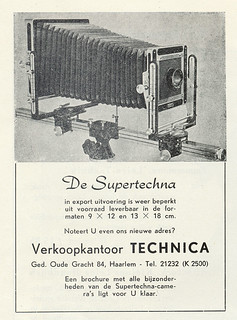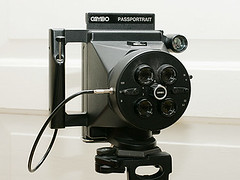Difference between revisions of "Cambo"
(+ref noting that Bok also worked with Old Delft; link to patent) |
m (Replaced fifth-level headings with simple bold (since there is no TOC, why make them headings)) |
||
| Line 1: | Line 1: | ||
{{Dutch companies}}__NOTOC__ | {{Dutch companies}}__NOTOC__ | ||
'''Cambo B. V. Fotografische Industrie''' is a manufacturer of high quality, mainly large format cameras. It is located in Kampen, the Netherlands, making it one of the very few Dutch camera makers. | '''Cambo B. V. Fotografische Industrie''' is a manufacturer of high quality, mainly large format cameras. It is located in Kampen, the Netherlands, making it one of the very few Dutch camera makers. | ||
| − | + | ||
| + | ==History== | ||
Roelof Bok started business as a cameramaker in 1945 in Hengelo, the Netherlands.<ref>Bok also designed items for [[Old Delft]], while in business in his own name. With a co-worker, Jan Griffioen, and Old Delft, he registered a patent for the mechanism in a film projector to synchronise the film-advance and a rotary shutter; [http://worldwide.espacenet.com/publicationDetails/originalDocument?CC=US&NR=3181174A&KC=A&FT=D&ND=3&date=19650427&DB=worldwide.espacenet.com&locale=en_EP US Patent 3181174], ''Variable intermittent film advancing means'', filed 18 July 1962 and granted 27 April 1965, and equivalent [http://worldwide.espacenet.com/publicationDetails/originalDocument?CC=FR&NR=1329373A&KC=A&FT=D&ND=3&date=19630607&DB=worldwide.espacenet.com&locale=en_EP French Patent 1329373], ''Projecteur cinématographique'', filed 20 July 1962 and granted 26 April 1963; archived at [http://worldwide.espacenet.com/?locale=en_EP Espacenet], the patent search facility of the European Patent Office.</ref> Bok's company was called ''Technica Hengelo'' and the first camera produced was the ''Super Techna''. When Bok tried to export his cameras, a possible confusion with the [[Linhof]] Technika cameras forced him to rename his products to ''Favero'' and later ''Cambo'' (i. e. '''Cam'''era '''Bo'''k). In 1965 the company moved to Kampen. Nowadays the company sees itself as supplier of architectural Cameras, digital applications, repro solutions, studio stands, shooting tables and other studio accessories as well as a range of portable HDSLR/Video supports. | Roelof Bok started business as a cameramaker in 1945 in Hengelo, the Netherlands.<ref>Bok also designed items for [[Old Delft]], while in business in his own name. With a co-worker, Jan Griffioen, and Old Delft, he registered a patent for the mechanism in a film projector to synchronise the film-advance and a rotary shutter; [http://worldwide.espacenet.com/publicationDetails/originalDocument?CC=US&NR=3181174A&KC=A&FT=D&ND=3&date=19650427&DB=worldwide.espacenet.com&locale=en_EP US Patent 3181174], ''Variable intermittent film advancing means'', filed 18 July 1962 and granted 27 April 1965, and equivalent [http://worldwide.espacenet.com/publicationDetails/originalDocument?CC=FR&NR=1329373A&KC=A&FT=D&ND=3&date=19630607&DB=worldwide.espacenet.com&locale=en_EP French Patent 1329373], ''Projecteur cinématographique'', filed 20 July 1962 and granted 26 April 1963; archived at [http://worldwide.espacenet.com/?locale=en_EP Espacenet], the patent search facility of the European Patent Office.</ref> Bok's company was called ''Technica Hengelo'' and the first camera produced was the ''Super Techna''. When Bok tried to export his cameras, a possible confusion with the [[Linhof]] Technika cameras forced him to rename his products to ''Favero'' and later ''Cambo'' (i. e. '''Cam'''era '''Bo'''k). In 1965 the company moved to Kampen. Nowadays the company sees itself as supplier of architectural Cameras, digital applications, repro solutions, studio stands, shooting tables and other studio accessories as well as a range of portable HDSLR/Video supports. | ||
{{brr}}{{Flickr_image | {{brr}}{{Flickr_image | ||
| Line 12: | Line 13: | ||
}} | }} | ||
| − | + | '''Current view cameras and camera systems for [[large format]], [[medium format]] digibacks and [[35mm]] format [[DSLR]] bodies''': | |
* [[Ultima Camera System]] | * [[Ultima Camera System]] | ||
* SC-2 | * SC-2 | ||
| Line 26: | Line 27: | ||
| | | | ||
| − | + | '''Older cameras:''' | |
* [[Cambo 45N]] | * [[Cambo 45N]] | ||
* [[Super Cambo]] | * [[Super Cambo]] | ||
| Line 59: | Line 60: | ||
|image_by=Siim Vahur | |image_by=Siim Vahur | ||
|image_rights= with permission | |image_rights= with permission | ||
| − | }}{{br}} | + | }} |
| + | {{br}} | ||
Revision as of 14:16, 1 October 2015
| ||||||
Cambo B. V. Fotografische Industrie is a manufacturer of high quality, mainly large format cameras. It is located in Kampen, the Netherlands, making it one of the very few Dutch camera makers.
History
Roelof Bok started business as a cameramaker in 1945 in Hengelo, the Netherlands.[1] Bok's company was called Technica Hengelo and the first camera produced was the Super Techna. When Bok tried to export his cameras, a possible confusion with the Linhof Technika cameras forced him to rename his products to Favero and later Cambo (i. e. Camera Bok). In 1965 the company moved to Kampen. Nowadays the company sees itself as supplier of architectural Cameras, digital applications, repro solutions, studio stands, shooting tables and other studio accessories as well as a range of portable HDSLR/Video supports.

|
| Cambo 5x4 Monorail camera image by Steve Smith (Image rights) |
Current view cameras and camera systems for large format, medium format digibacks and 35mm format DSLR bodies:
- Ultima Camera System
- SC-2
- Legend-2
- Wide DS
- Wide RS
- X2-Pro
- Sc. 2
- 45 Repro-D
- WDS-Repro
|
Older cameras:
|

|
| Supertechna advertisment image by Hans Kerensky (Image rights) |

|
| Passportrait Model 40 image by Siim Vahur (Image rights) |
Notes
- ↑ Bok also designed items for Old Delft, while in business in his own name. With a co-worker, Jan Griffioen, and Old Delft, he registered a patent for the mechanism in a film projector to synchronise the film-advance and a rotary shutter; US Patent 3181174, Variable intermittent film advancing means, filed 18 July 1962 and granted 27 April 1965, and equivalent French Patent 1329373, Projecteur cinématographique, filed 20 July 1962 and granted 26 April 1963; archived at Espacenet, the patent search facility of the European Patent Office.
Sources
Cambo website and Camera Beurs, issue winter/spring 1991/92
Links
- The Cambo Website